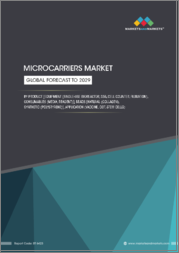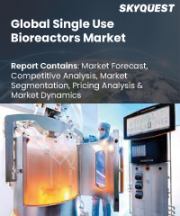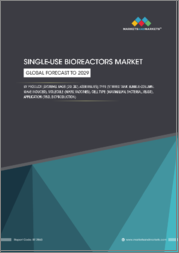
|
시장보고서
상품코드
1487520
일회용 바이오리액터 시장 : 세계 산업 분석, 규모, 점유율, 성장, 동향 및 예측(2024-2034년)Single-use Bioreactors Market - Global Industry Analysis, Size, Share, Growth, Trends, and Forecast, 2024-2034 |
||||||
일회용 바이오리액터 시장 - 조사 범위
TMR의 일회용 바이오리액터 세계 시장 조사 보고서는 2024년부터 2034년까지의 예측 기간 동안 시장 지표에 대한 귀중한 통찰력을 얻기 위해 과거뿐만 아니라 현재의 성장 동향과 기회를 조사했습니다. 이 보고서는 2024년을 기준 연도, 2034년을 예측 연도로 하여 2018년부터 2034년까지 전 세계 일회용 바이오리액터 시장의 수익과 예측을 제공합니다. 또한 2024년부터 2034년까지 세계 일회용 바이오리액터 시장의 연평균 복합 성장률(CAGR%)을 제시합니다.
이 보고서는 1차 조사에서 KOL(Key Opinion Leader), 업계 리더, 오피니언 제조업체를 인터뷰하고, 2차 조사에서 주요 기업의 제품 자료, 연례 보고서, 언론 보도, 관련 문서를 참고하여 일회용 바이오리액터 시장을 이해하고자 했습니다. 보도자료, 관련 문서를 참고하였습니다.
| 시장 현황 | |
|---|---|
| 2023년 시장 규모 | 21억 달러 |
| 2034년 시장 가치 | 67억 달러 |
| CAGR | 10.8% |
이 보고서는 세계 일회용 바이오리액터 시장 경쟁 구도를 심층적으로 분석합니다. 세계 일회용 바이오리액터 시장에서 활동하는 주요 기업들이 확인되었으며, 각 기업들은 다양한 속성으로 프로파일링되어 있습니다. 기업 개요, 재무 상태, 최근 동향 및 SWOT는 이 보고서에서 다루는 세계 일회용 바이오리액터 시장의 기업 속성입니다.
목차
제1장 서문
제2장 전제조건과 조사 방법
제3장 주요 요약 : 세계 시장
제4장 시장 개요
- 서론
- 시장 개요
- 시장 역학
- 세계 시장 분석과 예측, 2020-2034년
제5장 주요 인사이트
- 파이프라인 분석
- 주요 제품/브랜드 분석
- 주요 M&A
- COVID-19 팬데믹의 산업에 대한 영향
제6장 세계 시장 분석과 예측 : 제품 유형별
- 서론과 정의
- 주요 조사 결과/발전
- 시장 매출 예측 : 제품 유형별, 2020년-2034년
- 일회용 바이오리액터 시스템
- 미디어 백
- 여과 어셈블리
- 기타
- 시장의 매력 : 제품 유형별
제7장 세계 시장 분석과 예측 : 셀 타입별
- 서론과 정의
- 주요 조사 결과/발전
- 시장 매출 예측 : 세포 유형별, 2020년-2034년
- 포유류 세포
- 세균 세포
- 효모 세포
- 기타
- 시장의 매력 : 세포 유형별
제8장 세계 시장 분석과 예측 : 분자 유형별
- 서론과 정의
- 주요 조사 결과/발전
- 시장 매출 예측 : 분자 유형별, 2020년-2034년
- 단클론항체(MABs)
- 백신
- 줄기세포
- 유전자 변형 세포
- 기타
- 시장의 매력 : 분자 유형별
제9장 세계 시장 분석과 예측 : 최종사용자별
- 서론과 정의
- 주요 조사 결과/발전
- 시장 매출 예측 : 최종사용자별, 2020-2034년
- 바이오의약품 기업
- 바이오테크놀러지 기업
- 기타
- 시장의 매력 : 최종사용자별
제10장 세계 시장 분석과 예측 : 지역별
- 주요 조사 결과
- 시장 매출 예측 : 지역별, 2020-2034
- 북미
- 유럽
- 아시아태평양
- 라틴아메리카
- 중동 및 아프리카
- 시장의 매력 : 지역별
제11장 북미 시장 분석과 예측
제12장 유럽 시장 분석과 예측
제13장 아시아태평양 시장 분석과 예측
제14장 라틴아메리카 시장 분석과 예측
제15장 중동 및 아프리카 시장 분석과 예측
제16장 경쟁 구도
- 시장 경쟁 매트릭스(기업 Tier별, 기업 규모별)
- 시장 점유율 분석 : 기업별(2023년)
- 기업 개요
- Danaher Corporation
- General Electric Company
- Merck KGaA
- Sartorius AG
- Thermo Fisher Scientific, Inc.
- Eppendorf AG
- Parker Hannifin Corporation
- PBS Biotech, Inc.
- Distek, Inc.
- Getinge
Single-Use Bioreactors Market - Scope of Report
TMR's report on the global single-use bioreactors market studies the past as well as the current growth trends and opportunities to gain valuable insights of the indicators of the market during the forecast period from 2024 to 2034. The report provides revenue of the global single-use bioreactors market for the period 2018-2034, considering 2024 as the base year and 2034 as the forecast year. The report also provides the compound annual growth rate (CAGR %) of the global single-use bioreactors market from 2024 to 2034.
The report has been prepared after an extensive research. Primary research involved bulk of the research efforts, wherein analysts carried out interviews with key opinion leaders, industry leaders, and opinion makers. Secondary research involved referring to key players' product literature, annual reports, press releases, and relevant documents to understand the single-use bioreactors market.
| Market Snapshot | |
|---|---|
| Market Value in 2023 | US$ 2.1 Bn |
| Market Value in 2034 | US$ 6.7 Bn |
| CAGR | 10.8% |
Secondary research also included Internet sources, statistical data from government agencies, websites, and trade associations. Analysts employed a combination of top-down and bottom-up approaches to study various attributes of the global single-use bioreactors market.
The report includes an elaborate executive summary, along with a snapshot of the growth behavior of various segments included in the scope of the study. Moreover, the report throws light on the changing competitive dynamics in the global single-use bioreactors market. These serve as valuable tools for existing market players as well as for entities interested in participating in the global single-use bioreactors market.
The report delves into the competitive landscape of the global single-use bioreactors market. Key players operating in the global single-use bioreactors market have been identified and each one of these has been profiled in terms of various attributes. Company overview, financial standings, recent developments, and SWOT are the attributes of players in the global single-use bioreactors market profiled in this report.
Key Questions Answered in Global single-use bioreactors Market Report:
- What is the sales/revenue generated by single-use bioreactors across all regions during the forecast period?
- What are the opportunities in the global single-use bioreactors market?
- What are the major drivers, restraints, opportunities, and threats in the market?
- Which regional market is set to expand at the fastest CAGR during the forecast period?
- Which segment is expected to generate the highest revenue globally in 2034?
- Which segment is projected to expand at the highest CAGR during the forecast period?
- What are the market positions of different companies operating in the global market?
Single-Use Bioreactors Market - Research Objectives and Research Approach
The comprehensive report on the global single-use bioreactors market begins with an overview, followed by the scope and objectives of the study. The report provides detailed explanation of the objectives behind this study and key vendors and distributors operating in the market and regulatory scenario for approval of products.
For reading comprehensibility, the report has been compiled in a chapter-wise layout, with each section divided into smaller ones. The report comprises an exhaustive collection of graphs and tables that are appropriately interspersed. Pictorial representation of actual and projected values of key segments is visually appealing to readers. This also allows comparison of the market shares of key segments in the past and at the end of the forecast period.
The report analyzes the global single-use bioreactors market in terms of product, end-user, and region. Key segments under each criterion have been studied at length, and the market share for each of these at the end of 2034 has been provided. Such valuable insights enable market stakeholders in making informed business decisions for investment in the global single-use bioreactors market.
Table of Contents
1. Preface
- 1.1. Market Definition and Scope
- 1.2. Market Segmentation
- 1.3. Key Research Objectives
- 1.4. Research Highlights
2. Assumptions and Research Methodology
3. Executive Summary: Global Single-use Bioreactors Market
4. Market Overview
- 4.1. Introduction
- 4.1.1. Product Definition
- 4.1.2. Industry Evolution / Developments
- 4.2. Overview
- 4.3. Market Dynamics
- 4.3.1. Drivers
- 4.3.2. Restraints
- 4.3.3. Opportunities
- 4.4. Global Single-use Bioreactors Market Analysis and Forecast, 2020-2034
5. Key Insights
- 5.1. Pipeline Analysis
- 5.2. Key Product/Brand Analysis
- 5.3. Key Mergers & Acquisitions
- 5.4. COVID-19 Pandemic Impact on Industry
6. Global Single-use Bioreactors Market Analysis and Forecast, by Product Type
- 6.1. Introduction and Definitions
- 6.2. Key Findings/Developments
- 6.3. Market Value Forecast, by Product Type, 2020-2034
- 6.3.1. Single-use Bioreactor Systems
- 6.3.2. Media Bags
- 6.3.3. Filtration Assemblies
- 6.3.4. Others
- 6.4. Market Attractiveness, by Product Type
7. Global Single-use Bioreactors Market Analysis and Forecast, by Cell Type
- 7.1. Introduction and Definitions
- 7.2. Key Findings/Developments
- 7.3. Market Value Forecast, by Cell Type, 2020-2034
- 7.3.1. Mammalian Cells
- 7.3.2. Bacterial Cells
- 7.3.3. Yeast Cells
- 7.3.4. Others
- 7.4. Market Attractiveness, by Cell Type
8. Global Single-use Bioreactors Market Analysis and Forecast, by Molecule Type
- 8.1. Introduction and Definitions
- 8.2. Key Findings/Developments
- 8.3. Market Value Forecast, by Molecule Type, 2020-2034
- 8.3.1. Monoclonal Antibodies (MABs)
- 8.3.2. Vaccines
- 8.3.3. Stem Cells
- 8.3.4. Gene-modified Cells
- 8.3.5. Others
- 8.4. Market Attractiveness, by Molecule Type
9. Global Single-use Bioreactors Market Analysis and Forecast, by End-user
- 9.1. Introduction and Definitions
- 9.2. Key Findings/Developments
- 9.3. Market Value Forecast, by End-user, 2020-2034
- 9.3.1. Biopharmaceutical Companies
- 9.3.2. Biotechnology Companies
- 9.3.3. Others
- 9.4. Market Attractiveness, by End-user
10. Global Single-use Bioreactors Market Analysis and Forecast, by Region
- 10.1. Key Findings
- 10.2. Market Value Forecast, by Region, 2020-2034
- 10.2.1. North America
- 10.2.2. Europe
- 10.2.3. Asia Pacific
- 10.2.4. Latin America
- 10.2.5. Middle East & Africa
- 10.3. Market Attractiveness, by Region
11. North America Single-use Bioreactors Market Analysis and Forecast
- 11.1. Introduction
- 11.1.1. Key Findings
- 11.2. Market Value Forecast, by Product Type, 2020-2034
- 11.2.1. Single-use Bioreactor Systems
- 11.2.2. Media Bags
- 11.2.3. Filtration Assemblies
- 11.2.4. Others
- 11.3. Market Attractiveness, by Product Type
- 11.4. Market Value Forecast, by Cell Type, 2020-2034
- 11.4.1. Mammalian Cells
- 11.4.2. Bacterial Cells
- 11.4.3. Yeast Cells
- 11.4.4. Others
- 11.5. Market Attractiveness, by Cell Type
- 11.6. Market Value Forecast, by Molecule Type, 2020-2034
- 11.6.1. Monoclonal Antibodies (MABs)
- 11.6.2. Vaccines
- 11.6.3. Stem Cells
- 11.6.4. Gene-modified Cells
- 11.6.5. Others
- 11.7. Market Attractiveness, by Molecule Type
- 11.8. Market Value Forecast, by End-user, 2020-2034
- 11.8.1. Biopharmaceutical Companies
- 11.8.2. Biotechnology Companies
- 11.8.3. Others
- 11.9. Market Attractiveness, by End-user
- 11.10. Market Value Forecast, by Country/Sub-region, 2020-2034
- 11.10.1. U.S.
- 11.10.2. Canada
- 11.11. Market Attractiveness Analysis
- 11.11.1. By Product Type
- 11.11.2. By Cell Type
- 11.11.3. By Molecule Type
- 11.11.4. By End-user
- 11.11.5. By Country
12. Europe Single-use Bioreactors Market Analysis and Forecast
- 12.1. Introduction
- 12.1.1. Key Findings
- 12.2. Market Value Forecast, by Product Type, 2020-2034
- 12.2.1. Single-use Bioreactor Systems
- 12.2.2. Media Bags
- 12.2.3. Filtration Assemblies
- 12.2.4. Others
- 12.3. Market Attractiveness, by Product Type
- 12.4. Market Value Forecast, by Cell Type, 2020-2034
- 12.4.1. Mammalian Cells
- 12.4.2. Bacterial Cells
- 12.4.3. Yeast Cells
- 12.4.4. Others
- 12.5. Market Attractiveness, by Cell Type
- 12.6. Market Value Forecast, by Molecule Type, 2020-2034
- 12.6.1. Monoclonal Antibodies (MABs)
- 12.6.2. Vaccines
- 12.6.3. Stem Cells
- 12.6.4. Gene-modified Cells
- 12.6.5. Others
- 12.7. Market Attractiveness, by Molecule Type
- 12.8. Market Value Forecast, by End-user, 2020-2034
- 12.8.1. Biopharmaceutical Companies
- 12.8.2. Biotechnology Companies
- 12.8.3. Others
- 12.9. Market Attractiveness, by End-user
- 12.10. Market Value Forecast, by Country/Sub-region, 2020-2034
- 12.10.1. Germany
- 12.10.2. U.K.
- 12.10.3. France
- 12.10.4. Italy
- 12.10.5. Spain
- 12.10.6. Rest of Europe
- 12.11. Market Attractiveness Analysis
- 12.11.1. By Product Type
- 12.11.2. By Cell Type
- 12.11.3. By Molecule Type
- 12.11.4. By End-user
- 12.11.5. By Country/Sub-region
13. Asia Pacific Single-use Bioreactors Market Analysis and Forecast
- 13.1. Introduction
- 13.1.1. Key Findings
- 13.2. Market Value Forecast, by Product Type, 2020-2034
- 13.2.1. Single-use Bioreactor Systems
- 13.2.2. Media Bags
- 13.2.3. Filtration Assemblies
- 13.2.4. Others
- 13.3. Market Attractiveness, by Product Type
- 13.4. Market Value Forecast, by Cell Type, 2020-2034
- 13.4.1. Mammalian Cells
- 13.4.2. Bacterial Cells
- 13.4.3. Yeast Cells
- 13.4.4. Others
- 13.5. Market Attractiveness, by Cell Type
- 13.6. Market Value Forecast, by Molecule Type, 2020-2034
- 13.6.1. Monoclonal Antibodies (MABs)
- 13.6.2. Vaccines
- 13.6.3. Stem Cells
- 13.6.4. Gene-modified Cells
- 13.6.5. Others
- 13.7. Market Attractiveness, by Molecule Type
- 13.8. Market Value Forecast, by End-user, 2020-2034
- 13.8.1. Biopharmaceutical Companies
- 13.8.2. Biotechnology Companies
- 13.8.3. Others
- 13.9. Market Attractiveness, by End-user
- 13.10. Market Value Forecast, by Country/Sub-region, 2020-2034
- 13.10.1. China
- 13.10.2. Japan
- 13.10.3. India
- 13.10.4. Australia & New Zealand
- 13.10.5. Rest of Asia Pacific
- 13.11. Market Attractiveness Analysis
- 13.11.1. By Product Type
- 13.11.2. By Cell Type
- 13.11.3. By Molecule Type
- 13.11.4. By End-user
- 13.11.5. By Country/Sub-region
14. Latin America Single-use Bioreactors Market Analysis and Forecast
- 14.1. Introduction
- 14.1.1. Key Findings
- 14.2. Market Value Forecast, by Product Type, 2020-2034
- 14.2.1. Single-use Bioreactor Systems
- 14.2.2. Media Bags
- 14.2.3. Filtration Assemblies
- 14.2.4. Others
- 14.3. Market Attractiveness, by Product Type
- 14.4. Market Value Forecast, by Cell Type, 2020-2034
- 14.4.1. Mammalian Cells
- 14.4.2. Bacterial Cells
- 14.4.3. Yeast Cells
- 14.4.4. Others
- 14.5. Market Attractiveness, by Cell Type
- 14.6. Market Value Forecast, by Molecule Type, 2020-2034
- 14.6.1. Monoclonal Antibodies (MABs)
- 14.6.2. Vaccines
- 14.6.3. Stem Cells
- 14.6.4. Gene-modified Cells
- 14.6.5. Others
- 14.7. Market Attractiveness, by Molecule Type
- 14.8. Market Value Forecast, by End-user, 2020-2034
- 14.8.1. Biopharmaceutical Companies
- 14.8.2. Biotechnology Companies
- 14.8.3. Others
- 14.9. Market Attractiveness, by End-user
- 14.10. Market Value Forecast, by Country/Sub-region, 2020-2034
- 14.10.1. Brazil
- 14.10.2. Mexico
- 14.10.3. Rest of Latin America
- 14.11. Market Attractiveness Analysis
- 14.11.1. By Product Type
- 14.11.2. By Cell Type
- 14.11.3. By Molecule Type
- 14.11.4. By End-user
- 14.11.5. By Country/Sub-region
15. Middle East & Africa Single-use Bioreactors Market Analysis and Forecast
- 15.1. Introduction
- 15.1.1. Key Findings
- 15.2. Market Value Forecast, by Product Type, 2020-2034
- 15.2.1. Single-use Bioreactor Systems
- 15.2.2. Media Bags
- 15.2.3. Filtration Assemblies
- 15.2.4. Others
- 15.3. Market Attractiveness, by Product Type
- 15.4. Market Value Forecast, by Cell Type, 2020-2034
- 15.4.1. Mammalian Cells
- 15.4.2. Bacterial Cells
- 15.4.3. Yeast Cells
- 15.4.4. Others
- 15.5. Market Attractiveness, by Cell Type
- 15.6. Market Value Forecast, by Molecule Type, 2020-2034
- 15.6.1. Monoclonal Antibodies (MABs)
- 15.6.2. Vaccines
- 15.6.3. Stem Cells
- 15.6.4. Gene-modified Cells
- 15.6.5. Others
- 15.7. Market Attractiveness, by Molecule Type
- 15.8. Market Value Forecast, by End-user, 2020-2034
- 15.8.1. Biopharmaceutical Companies
- 15.8.2. Biotechnology Companies
- 15.8.3. Others
- 15.9. Market Attractiveness, by End-user
- 15.10. Market Value Forecast, by Country/Sub-region, 2020-2034
- 15.10.1. GCC Countries
- 15.10.2. South Africa
- 15.10.3. Rest of Middle East & Africa
- 15.11. Market Attractiveness Analysis
- 15.11.1. By Product Type
- 15.11.2. By Cell Type
- 15.11.3. By Molecule Type
- 15.11.4. By End-user
- 15.11.5. By Country/Sub-region
16. Competition Landscape
- 16.1. Market Player - Competition Matrix (By Tier and Size of Companies)
- 16.2. Market Share Analysis, by Company (2023)
- 16.3. Company Profiles
- 16.3.1. Danaher Corporation
- 16.3.1.1. Company Overview (HQ, Business Segments, Employee Strength)
- 16.3.1.2. Product Portfolio
- 16.3.1.3. Financial Overview
- 16.3.1.4. SWOT Analysis
- 16.3.1.5. Strategic Overview
- 16.3.2. General Electric Company
- 16.3.2.1. Company Overview (HQ, Business Segments, Employee Strength)
- 16.3.2.2. Product Portfolio
- 16.3.2.3. Financial Overview
- 16.3.2.4. SWOT Analysis
- 16.3.2.5. Strategic Overview
- 16.3.3. Merck KGaA
- 16.3.3.1. Company Overview (HQ, Business Segments, Employee Strength)
- 16.3.3.2. Product Portfolio
- 16.3.3.3. Financial Overview
- 16.3.3.4. SWOT Analysis
- 16.3.3.5. Strategic Overview
- 16.3.4. Sartorius AG
- 16.3.4.1. Company Overview (HQ, Business Segments, Employee Strength)
- 16.3.4.2. Product Portfolio
- 16.3.4.3. Financial Overview
- 16.3.4.4. SWOT Analysis
- 16.3.4.5. Strategic Overview
- 16.3.5. Thermo Fisher Scientific, Inc.
- 16.3.5.1. Company Overview (HQ, Business Segments, Employee Strength)
- 16.3.5.2. Product Portfolio
- 16.3.5.3. Financial Overview
- 16.3.5.4. SWOT Analysis
- 16.3.5.5. Strategic Overview
- 16.3.6. Eppendorf AG
- 16.3.6.1. Company Overview (HQ, Business Segments, Employee Strength)
- 16.3.6.2. Product Portfolio
- 16.3.6.3. Financial Overview
- 16.3.6.4. SWOT Analysis
- 16.3.6.5. Strategic Overview
- 16.3.7. Parker Hannifin Corporation
- 16.3.7.1. Company Overview (HQ, Business Segments, Employee Strength)
- 16.3.7.2. Product Portfolio
- 16.3.7.3. Financial Overview
- 16.3.7.4. SWOT Analysis
- 16.3.7.5. Strategic Overview
- 16.3.8. PBS Biotech, Inc.
- 16.3.8.1. Company Overview (HQ, Business Segments, Employee Strength)
- 16.3.8.2. Product Portfolio
- 16.3.8.3. Financial Overview
- 16.3.8.4. SWOT Analysis
- 16.3.8.5. Strategic Overview
- 16.3.9. Distek, Inc.
- 16.3.9.1. Company Overview (HQ, Business Segments, Employee Strength)
- 16.3.9.2. Product Portfolio
- 16.3.9.3. Financial Overview
- 16.3.9.4. SWOT Analysis
- 16.3.9.5. Strategic Overview
- 16.3.10. Getinge
- 16.3.10.1. Company Overview (HQ, Business Segments, Employee Strength)
- 16.3.10.2. Product Portfolio
- 16.3.10.3. Financial Overview
- 16.3.10.4. SWOT Analysis
- 16.3.10.5. Strategic Overview
- 16.3.1. Danaher Corporation



















